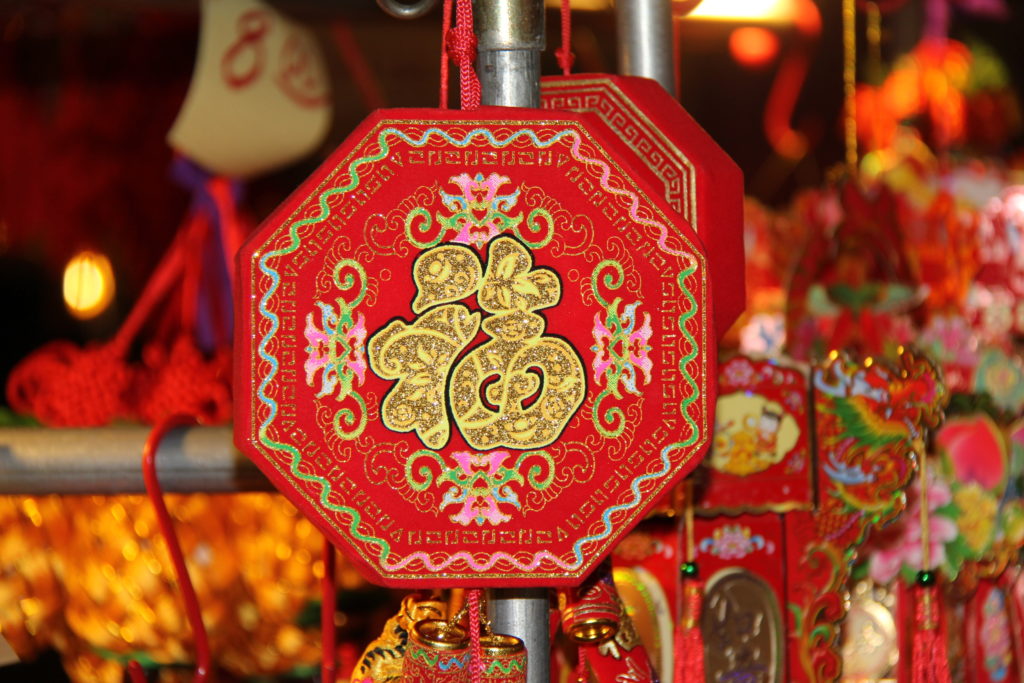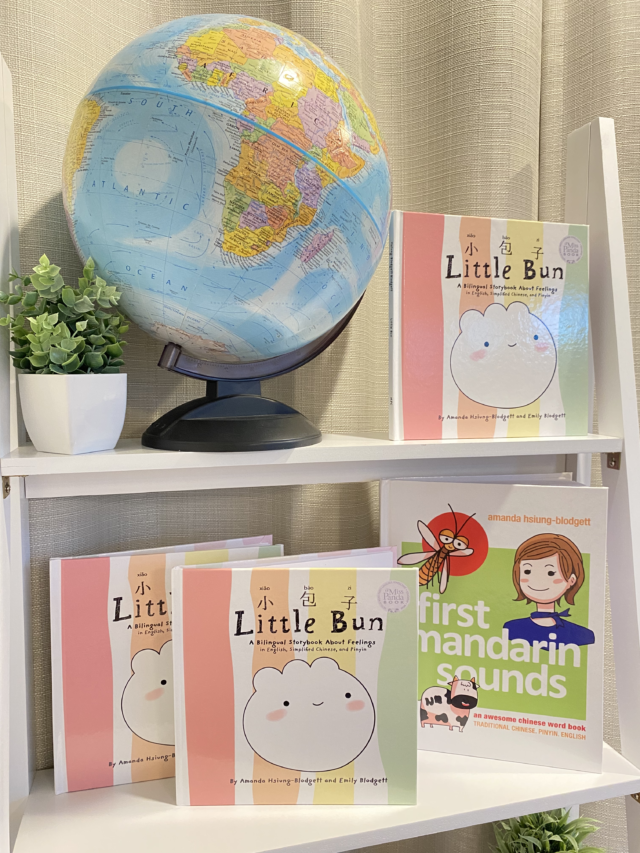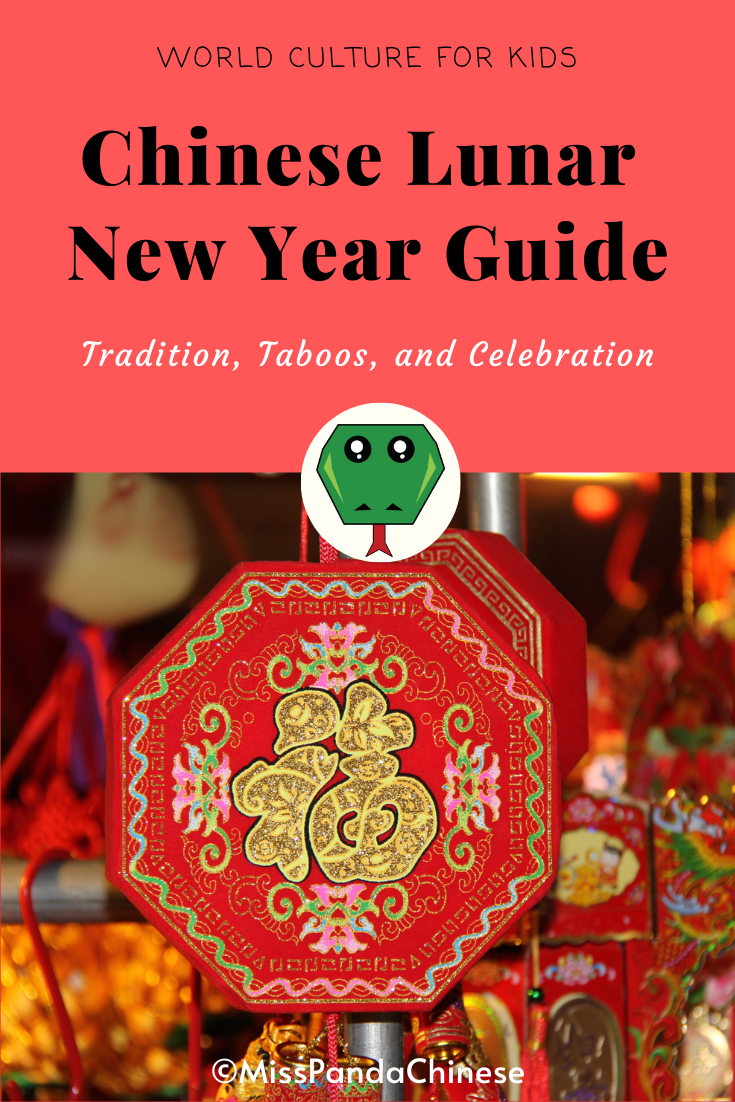Chinese Lunar New Year Guide – Tradition, Taboos, and Celebration | Chinese Culture for Kids Series *Free Year of the Snake coloring pages in More Resources section!
The year of the SNAKE is arriving on January 29, 2025
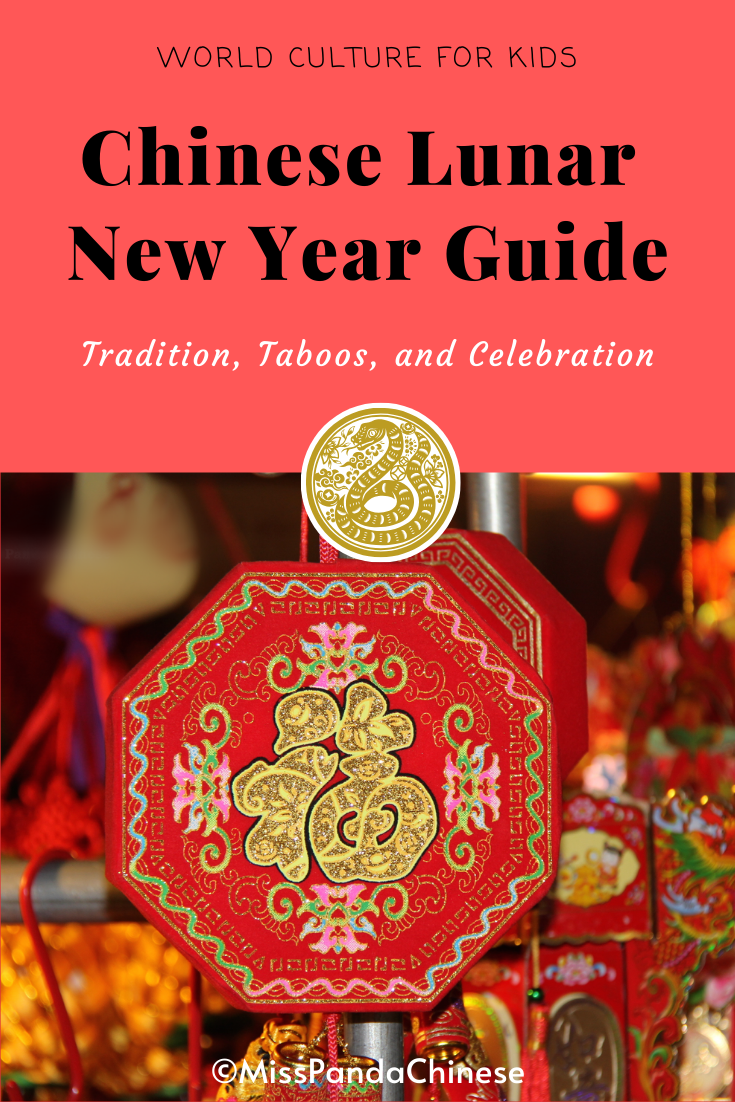
Chinese Lunar New Year Guide – Tradition, Taboos, and Celebration
“Gong Xi! Gong Xi!”–The Excitement of Chinese Lunar New Year
Chinese Lunar New Year Guide starts here…
The fragrance of Mom’s special stew and the “Ten Vegetarian Delights” fill the kitchen just before the Lunar New Year arrives. That’s the first memory that floods into my mind each time someone asks me about the Chinese Lunar New Year celebration.
In my opinion, it’s the best of all Chinese festivals and has been my favorite since I was a little girl.
Growing up with Lunar New Year
Lunar New Year – nóng lì xīn nián – 農曆新年 | 农历新年
Links of sausage, strips of bacon, and cured fish hung to dry on bamboo rods (back then the equivalent of clotheslines in the West) in almost every yard.
We would run around with friends from one yard to another to check out how soon these goodies would be ready to eat.
The smell of all the cured meat was another one of the indicators to me that the Chinese Lunar New Year was just around the corner.
Vendors with all kinds of New Year decorations, such as large gold-nugget-shaped candy containers, paper-cutting artwork, and spring scrolls with lucky words are everywhere in the open market and the stores.
For a small fee, professional calligraphers will even write your spring scrolls for you with their big Chinese calligraphy brushes.
Big and small rolls of firecrackers are being sold and traditional Chinese New Year music fills the air of the open market as you walk through the crowd.
The Fifteen Days of the Chinese New Year Celebration
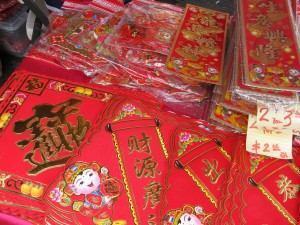
Chinese Lunar New Year Lucky Phrase Couplets at the Open Market in Honolulu, Hawaii. Photo by Miss Panda.
Preparations kick-off
The preparations for the Chinese Lunar New Year start on the 23rd day of the last month on the Chinese lunar calendar. On this day, the tradition is to send the “kitchen god” (the protector of the family and the most important of Chinese domestic gods in Chinese mythology) back to the sky to report to the Jade Emperor (the supreme ruler of all heaven and earth) about how the family has been doing the whole year.
The portrait of the kitchen god is posted on the wall in the kitchen. Families might spread melted sweets on the mouth of the kitchen god’s picture so that he would go and say only sweet and good things about the family.
Out with the Old and In with the New – Chú jiù bù xīn 除舊佈新 • 除旧布新
The next few days see a major cleaning of the house. All clutter should be removed, the house dusted from ceiling to floor and the bedding in each room thoroughly washed. “Chú jiù bù xīn” (除舊佈新 | 除旧布新 remove the old and decorate the new) is the concept behind this major cleanup.
We are also welcoming the new year by posting lucky, red paper spring scrolls on the front door. Phrases or words like “xīn nián kuài lè” (新年快樂 | 新年快乐 Happy New Year); “Gong xǐ fa cái” ( 恭喜發財 | 恭喜发财 congratulations and prosperity) and “ Fú” (福 Good fortune) and “Chun” ( 春 spring) can be been seen on doors everywhere.
The Chinese New Year’s Eve Family Feast – tuán yuán fàn – 團圓飯• 团圆饭
Chinese New Year’s Eve dinner marks the beginning of the Chinese New Year celebration.
This is a family reunion feast bringing together grandparents, or even great-grandparents, down to newborn babies. It is a celebration of the togetherness of the family.
It is very important to have a Chinese New Year’s Eve dinner with the family. People make every effort to be back in their hometown as soon as the festival holidays begin.
For those who cannot make it to the dinner because of work or being overseas, parents will prepare a seat and set up everything for him or her to represent the reunion of every member of the family.
My mother always prepares ten dishes for New Year’s Eve’s dinner and every dish is a special treat. Fish is a must-have dish. The word for fish in Mandarin Chinese is “yú” and it has the same sound as the Chinese word for “remaining” or “surplus.“
We never finish the fish dish because we want to save one big piece of the fish to symbolize a surplus of wealth and all things good in the new year. The Chinese New Year saying that goes with this practice is “nián nián yǒu yú” – “年年有餘 Every year (we) have leftover/surplus (wealth).”
Red Envelopes – Hóng bāo – 紅包 | 红包
After the family meal, it is time to say lucky words to grandparents and parents and it is time for the Red Envelope. In my family we use the traditional Chinese style, we kneel in front of Mom and Dad and bow to say auspicious phrases like:
Xīn nián kuài lè 新年快樂 | 新年快乐 Happy New Year
Shēn tǐ jiàn kāng 身體健康 | 身体健康 Good health
Wàn shì rú yì 萬事如意 | 万事如意 May everything goes as you wish
Gong xǐ fā cái 恭喜發財 | 恭喜发财 Congratulations and prosperity
Then Mom and Dad give each of us a red envelope with cash in it. Instead of spending the cash right away, the tradition is to put the red envelope under your pillow so that it will keep you young and healthy.
When the children are grown up and independent then it becomes their turn to give red envelopes to their parents. I remember how proud I was when I gave my parents red envelopes when I first started working.
Lunar New Year Gift Ideas that you might find helpful for gifting books, games, decors, crafts, and snacks!
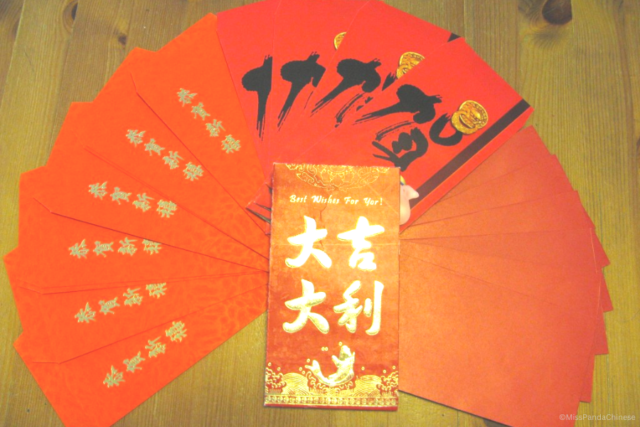
Taboos
For the first few days of the new year, some families do not use knives or scissors to lessen the risk of cuts and accidents, which would signify bad luck for the year.
Some families do not sweep the floor to avoid symbolically sweeping away their wealth. If something is broken like a glass or a bowl you will hear people immediately say “suì suì píng ān” 歲歲平安|岁岁平安, which means every year is safe and peaceful.
Why? It is a play on words, as the Chinese word for “broken” has the same sound as the word “year”. The rule of thumb during this time is to say good and sweet things to bring on a good and sweet year.
Firecracker Fun
On Lunar New Year’s Eve families stay up late to enjoy family time and catch up with the visiting brothers, sisters, aunts, uncles, and cousins. The most exciting time of the evening for me was when we set off firecrackers.
There are all kinds of firecrackers biān bào 鞭炮, some spin, some fly, some hop, some shoot high and some have beautiful showers of sparks with a huge explosion at the end. We play hard and stay up past midnight.
The tradition of staying up late on New Year’s Eve is good luck and is said to give parents long life! At midnight we set off the long strings of firecrackers to welcome in the new year!
The 15th day of the Chinese New Year – Lantern Festival 元宵節|元宵节 –Yuán xiāo jié
The Lantern Festival marks the completion and the end of the Chinese New Year celebration.
On this day, children carry lanterns around in the park or the neighborhood. When I was a little girl my brother and other neighborhood boys would help me make a lantern out of a tin milk can.
We used nails and hammers to poke holes in the bottom of the tin can and then placed a candle inside. An iron wire will be attached to the top to make a handle and then a wooden stick will be attached to the wire to carry the lantern.
The older boys would use bamboo sticks to make torches. As soon as it got dark, you would see the torches and lanterns everywhere. Now, we don’t see torches or tin lanterns anymore.
Instead, you see beautifully designed paper lanterns with battery-operated lights for children. It is always a fascinating scene when you walk in the park and see hundreds of children carrying their flashing lanterns around.
Chinese Lunar New Year Greetings, Culture and Craft Projects Pack (available on TpT Miss Panda Chinese)
Craft projects included Lucky Word Banners, Papercutting templates, Bookmarks, Greeting Cards, Mazes, Puzzles, 12 Chinese Zodiac puzzles, Zodiac Lantern, and many more!
Music
Music is an important part of the Chinese New Year just like Christmas carols are an important part of that celebration in the West.
We hear traditional New Year’s tunes on the radio, on TV, on the street, in the stores, and in the markets.
The one you will hear over and over again is the “Gong Xi, Gong Xi” song. It is a fun and easy one.
I have a short and simple version of this song performed by the fantastic Miss Panda Band! You can find the lyrics in Pinyin and English translation. You can listen to it here. I hope you enjoy it.
Měi tiáo dà jiē xiǎo xiàng
(每條大街小巷 |Every big street little alley)
Měi gè rén de zuǐ lǐ
(每個人的嘴裡 |In everyone’s mouth)
Jiàn miàn dì yī jù huà
(見面第一句話 |The first sentence (we) say when (we) see each other)
Jiù shì gong xǐ gong xǐ
(就是恭喜恭喜 |Must be” “Congratulations! Congratulations!”)
Gōng xǐ, gong xǐ, gong xǐ nǐ ya,
(恭喜 恭喜 恭喜你呀 |Congratulations! Congratulations! Congratulations to you!)
Gong xǐ, gong xǐ, gong xǐ nǐ
(恭喜 恭喜 恭喜你 |Congratulations! Congratulations! Congratulations to you!)
Celebrating away from “home”
Now I am far and away from Taiwan where I grew up. What I always do when the Chinese Lunar New Year is approaching is call my Mom and ask her what she is doing.
She tells me she is preparing the “Ten Vegetarian Delights” and that she has started the stew. I tell her that I can smell it already. She chuckles and replies “How is that possible?”
Then my Dad takes over and tells me it indeed smells incredible and that he will mail the dish to me from the West Coast by an express carrier to ensure its freshness.
We all end up laughing about the idea and sharing the great memories we have of the festival. This is what I love the most about the Chinese New Year – the celebration of the family!
Happy Lunar New Year! Happy Spring Festival! Have an amazing Year of the SNAKE! Your Chinese birth sign is SNAKE if your birth year is 2025, 2013, 2001, 1989, 1977, 1965, 1953, 1941, 1929, 1917…
What is the personality feature of people born in the year of the SNAKE? They are believed to be creative, intelligent, and charming. Do you know someone who was born in the year of the SNAKE? Do the characteristics match with him/her?
Share any celebration or activity you do at home, in class, or at school during the Chinese Lunar New Year in the comment!
Do you know that the Year of the SNAKE is also known as the Year of the “Little Dragon?”
Q&A:
Q1. What do Chinese people call the Lunar New Year in Chinese?
There are different ways to say it and here are the common variations you will hear from Chinese native speakers. But, one that everyone says is 過年•过年 “guò nián.” Before the Lunar New Year arrives, people say, 要過年了 • 要过年了 “yào guò nián lè.” When the Lunar New Year arrives, for example, the first day of the Lunar New Year, people say, “guò nián lè”
Lunar New Year – nóng lì nián – 農曆年 | 农历年
Old Calendar New Year – jiù lì nián – 舊曆年 | 旧历年
Yin Calendar New Year – yīn lì nián – 陰曆年 | 阴历年
Spring Festival – chūn jié – 春節 | 春节
(Celebrate) the New Year – guò nián – 過年 | 过年 – Guò is “cross” and here literally means “cross the year,” which means going from one year to the next like from December 31, 2024, to January 1, 2025.
Q2. Is it the Lunar New Year or Chinese New Year in English?
Lunar New Year is celebrated in East Asia. In Chinese, the Lunar New Year or Spring Festival has various names in different countries.
In Korea, it is Seollal. It is Têt in Vietnam. In Mongolia, it is Tsaagan Sar.
Lunar New Year is one of the world’s biggest celebrations observed in China, Taiwan, Singapore, Korea, Indonesia, Vietnam, Malaysia, Mongolia, and the diasporas of China, Taiwan, Korea, and Vietnam. Please note that Japan is one of the few countries that doesn’t celebrate the Lunar New Year in Asia.
We need to understand that all countries that celebrate the Lunar New Year have similar and different traditions. Therefore, in English, you may have heard people call the Lunar New Year – the Chinese New Year, the Vietnamese New Year, and the Korean New Year… Each country that observes the Lunar New Year has its unique traditions to celebrate the most important cultural festival in their culture. This post, “The Chinese Lunar New Year Guide” refers to how Lunar New Year is celebrated in the Chinese community.
Sometimes, some words have a translation gap, then a meaning translation will be applied to give a reference. For example, the Dragon Boat Festival – is called Dūan Wǔ Jié in Chinese, and the boat race is one of its major activities for this cultural festive – the Dragon Boat race. Therefore, in English, it is translated into the Dragon Boat Festival. We can see most of the cultural holidays are translated this way.
We want to be respectful of the unique cultural differences and, at the same time, we want to learn about how people from different countries call these festivals in their native language. Our community is diverse and, with the internet, we are closer in distance (virtually) than ever before. We all have the opportunity to ask friends about what they prefer to call these cultural festivals.
Being curious is the first step to learn about each other.
In a recent Lunar New Year celebration I hosted a celebration at home with friends who are from Taiwan, China, Japan, Korea, and Vietnam. During the conversation, we used Lunar New Year and Chinese New Year interchangeably. However, when we talked about unique traditions, Vietnamese New Year or Korean New Year was used.
When you send friends and their families your Lunar New Year greetings they can feel your kindness and shared joy.
Q3. What are the 12 Chinese Zodiac Signs? Are they called Zodiac Signs?
Chinese people call the 12 animals that rotate with the year ” The Twelve Birth Signs. 十二生肖”
The animal birth signs originated from the Chinese culture and have influenced some East Asian and Southeastern Asian countries, such as Korea, Vietnam, Cambodia, Singapore, Thailand,…etc. But, there are similarities and differences. There are variations of the animal birth signs and here is a comparison.
The animal signs used in Japan, Korea, and Singapore are almost identical to the 12 Chinese animal signs. Check out the variations!
-
Japan: The only difference is that the pig is replaced by a boar. Japan is one of the Asian countries that does not celebrate the Lunar New Year. In 1873, it began using the Gregorian calendar and started celebrating the New Year on January 1st.
-
Cambodia: The only minor difference is that the dragon is interchangeable with the sea snake (Nāga).
-
Nepal: There are several differences here. Rabbit is replaced by CAT. Dragon is replaced by EAGLE. Chicken is replaced by BIRD and DEAR takes the place of the pig.
-
Vietnam: Rabbit is replaced by CAT! Both Nepal and Vietnam have CAT on the list.
-
Thailand: The 12 animals are Rat, Ox, Tiger, Rabbit, Naga, Snake, Horse, Goat, Monkey, Rooster, Dog, and Pig. Have you noticed that NĀGA replaced the dragon once again?
-
Myanmar: The Burmese animal signs are from ancient monks of Myanmar. The animals are used for directions and the days of the week. The eight animals are Garuda (Sunday), Tiger (Monday), Lion (Tuesday), Elephant with tusks (Wednesday AM) – Elephant without tusks (Wednesday PM), Rat (Thursday), Guinea pig (Friday), and Dragon (Saturday).
For the curious young mind, you can share that there are different lists and CAT is actually on the list!
Welcome the Year of the SNAKE and write the word, snake – shé – 蛇 in Chinese. Can you follow the stroke and write your own? The Traditional Chinese and the Simplified Chinese forms are the same. [Animiation Credit: Ministry of Education, R.O.C.]
Exploring More Resources in Chinese for Kids Chinese New Year Series
Year of the SNAKE 2025 – Swirl Lucky Snake Craft Project (coming soon – original version here)
Lunar New Year of the SNAKE – Coloring pages (FREE, download TCh here or SCh here)
Teaching Resource: 12 Chinese Animal Signs Activity & Culture Learning Unit
Teaching Resource: Greetings & Crafts Learning Unit
12 Chinese Animal Signs Posters Learning Unit
Read Your World: 12 Chinese Lunar New Year & Culture Books
Learning about the 12 Chinese Animal Birth Signs (Chinese Zodiac)
Year of the Snake Craft
Make a Chinese New Year Lucky Word Sign Fú Craft
Lunar New Year Lantern Festival Riddle Game Printable
Chinese Lunar New Year Classic Greeting Coloring Pages
Chinese Lunar New Year Let’s Make Dumplings A Must-Have Recipe
Winter Solstice Dōng Zhì Festival
Chinese Lunar New Year Laba Festival
Listed below are the Premium Project-Based Lunar New Year Learning Packs –
Traditional Chinese with English and Pinyin support version
Simplified Chinese with English and Pinyin support version
Video Resources
Chinese New Year Must-Know Lucky Phrases!
Explore More About the Chinese Lunar New Year –
Chinese New Year Traditions with HISTORY
Discovering China – Chinese Lunar New Year
Video The Story of Chinese New Year
The Legend of Nian
Dad’s Manual (Mandarin)
The Chinese Zodiac (The 12 Chinese Birth Signs)
Fun Chinese Characters
Love to read more about bilingual Chinese language and culture teaching from Miss Panda? Sign up for the Email Updates:
Fortune cookies are created by the Japanese. They are served in restaurants in Asia. However, It is something people see in most Chinese restaurants in the U.S. Prepare some papers and follow the origami fortune cookies craft idea here.
Chinese Lunar New Year Guide | Chinese Lunar New Year Guide | Chinese Lunar New Year Guide | Chinese Lunar New Year Guide
